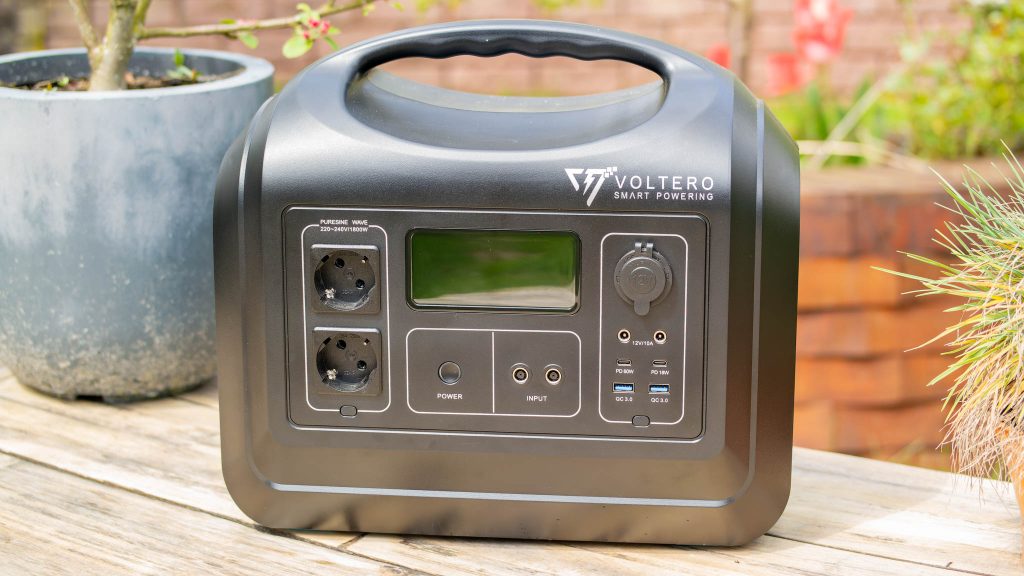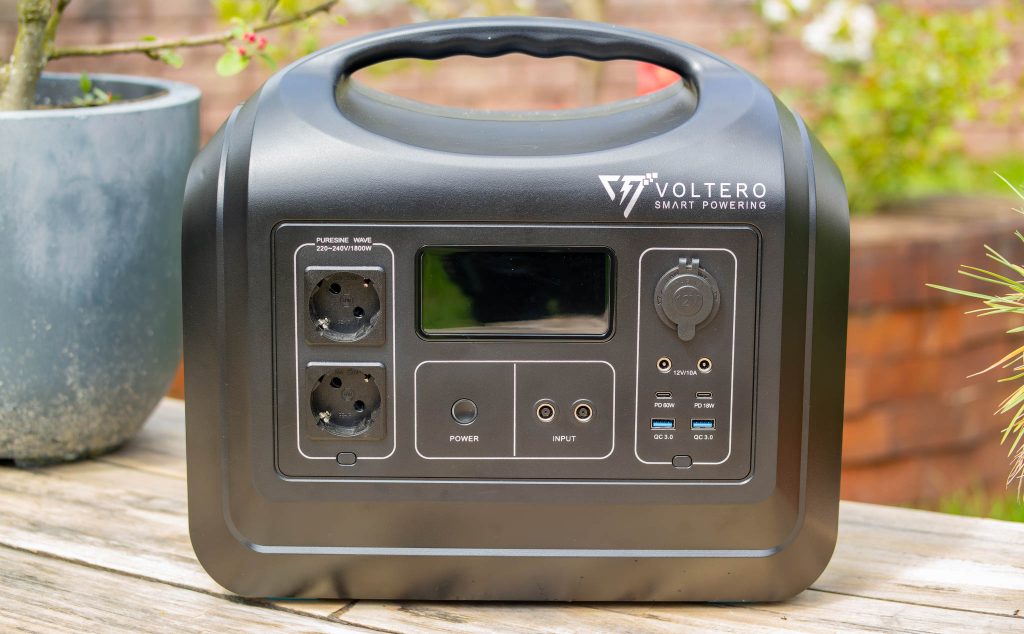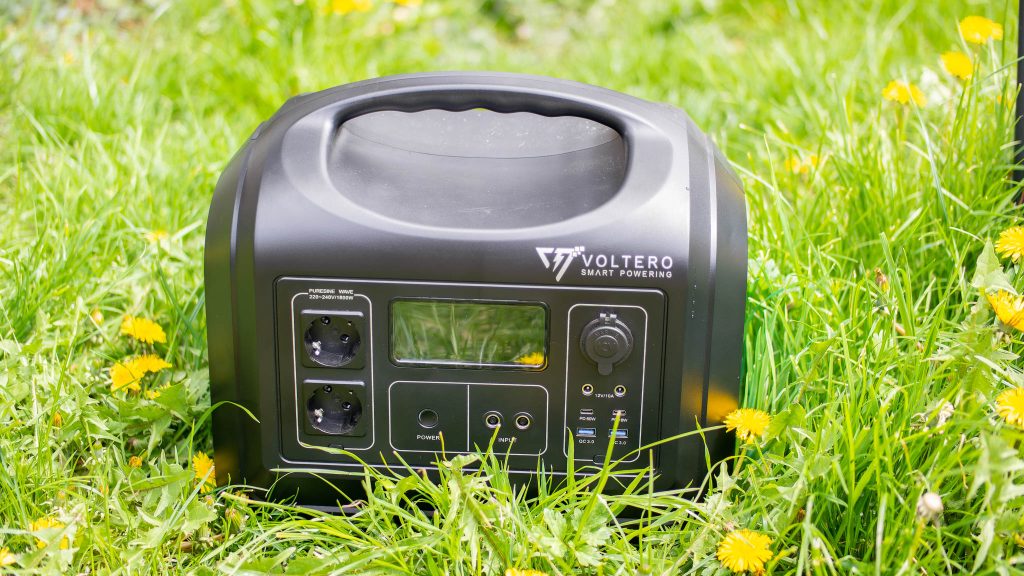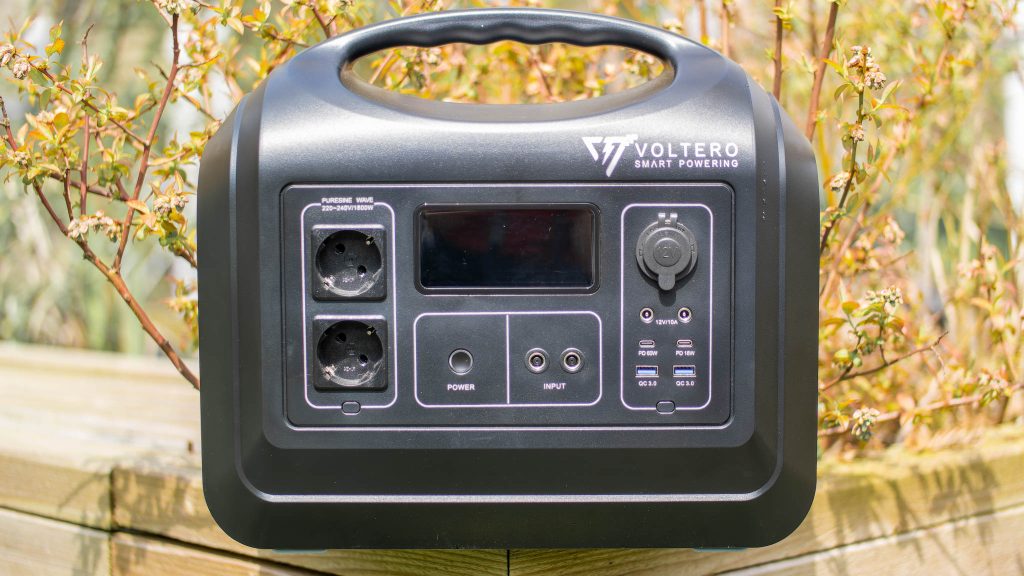There are now hundreds, if not thousands, of power stations on the market and new manufacturers and models are added almost every day.
One of these new manufacturers is VOLTERO, which has an interesting line-up of power stations in its range.
This review is about the currently 2nd largest model, the PS18.
With 1488 Wh and an output power of up to 1800W, the VOLTERO PS18 is quite a large power station.
But is the PS18 also a good power station? Let’s find out in the test!
Case and dimensions
VOLTERO uses a rather classic plastic housing for the PS18. This is largely black with blue accents on the side.
The build quality is good, but in general the case is not exceptional. Thus, the PS18 is not a premium power station purely in terms of the housing, but rather a mid-range model.
Due to the rather high capacity of 1488Wh, the somewhat larger dimensions of 385 x 243 x 340 mm and the weight of 15Kg are not surprising. I would say that the size of the Powerstation “fits”.
For easier transport, it has a large carrying handle on the top.
Ports of the PS18
On the front of the Powerstation we find the following Ports:
2x 220-240V Schuko socket with up to 1800W constant power or 4000W peak power.
1x cigarette lighter socket 12V/10A
2x DC outputs 12V/10A
2x USB A Quick Charge 18W
2x USB C USB Power Delivery 60W
This is pretty optimal as far as it goes. It would just be nice to have two 100W USB C ports instead of the two 60W ports. However, the two 60W ports are already good for medium-sized notebooks and smartphones.
In addition, there are the two very powerful sockets.
With display
On the front of the power station you will find a display that shows you basic information such as the current charge level, power input and output, etc. The display is very helpful!
The display is very helpful!
Capacity and battery
Inside the VOLTERO PS18 you will find LiFePO4 battery cells. These are much more durable and safer than classic lithium ion cells.
More information about LiFePO4 cells can be found here: https://akkutest.org/test-eco-worthy-lifepo4-12v-100ah-akku-mit-werten-nach-1-jahr-nutzung/
On the durability side, VOLTERO promises 3500+ cycles, which is quite a lot.
On the capacity side, according to the manufacturer we have 1488 Wh, here’s what I was able to measure:
| Wh | |
| USB C 60W | 1269 |
| DC 12V/5A | 1258 |
| AC 50W | 1043 |
| AC 300W | 1263 |
| AC 1500W | 1210 |
In the test, the capacity of the Powerstation fluctuated between 1043Wh at minimum and 1269Wh at maximum. This corresponds to 70% to 85% of the manufacturer’s specification, which is a good value.
With USB C
The Powerstation has two USB C ports.
Port 1 60W 5V/3A, 9V/3A, 12V/3A, 15V/3A, 20V/3.25A
Port 2 18W 5V/3A, 9V/2A, 12V/1.5A
Both ports use the USB Power Delivery standard. These are compatible with almost all smartphones and also larger devices such as notebooks.
This allows you to charge devices like the MacBook Pro 13, Dell XPS 13, etc. directly from the power station, which is much more efficient.
Fortunately, the 60W USB C port supports PPS. The PPS range of 5-11V at 3A is sufficiently good.
Fan
A fan is built into the Powerstation. It seems to have two power levels. Up to a load of approx. 100W, the fan remains off; from 100W, the fan slowly starts up.
It is audible, but quite discreet. Only at full load does the fan turn up to full speed.
Simultaneous charging/discharging
You can charge and discharge the VOLTERO PS18 at the same time. This is especially important if you use it with a solar panel.
But you can also use the connections on the mains adapter at the same time as you charge it. Therefore, in principle, it can also be used as a UPS.
However, since we only have a 200W power supply, the UPS use should not exceed the power of approx. 100-125W, because otherwise the Powerstation would switch off.
The efficiency during use is ok.
| 25W | 44% |
| 50W | 59% |
| 100W | 72% |
| 150W | 81% |
It varies between 44% at very low load and 81% at higher load.
Switchover times when unplugging the power supply seemed unproblematic. My PCs just continued to run normally.
Charging time and charging options for the Power Station
As with most Power Stations, you have several charging options with the VOLTERO PS18.
Via the included 200W power supply unit
Via a 12V/8A car plug
Via solar 2x 12-30V maximum 200W
The Powerstation comes with a 200W power supply unit.
This can fully charge the Powerstation in approx. 7:50h.
Alternatively, you can also charge the Powerstation with a car power supply with up to 12V/10A, i.e. 120W.
Charging via solar is also possible. The VOLTERO PS18 accepts two panels with a voltage range of 12-30V and a maximum of 200W (per panel). Theoretically, you could fill the Powerstation twice as fast via the sun with suitable panels as with the mains adapter.
Fortunately, VOLTERO includes suitable adapters for normal MC4 plugs. So you can use universal solar panels here. Incidentally, the DC input is the same connection that Jackery uses on its models.
Charging efficiency of the PS18
Let’s look at the charging efficiency, i.e. how much energy we need to fill the Powerstation versus the energy we can use at the end.
Via the mains adapter, the Powerstation needed 1715 Wh for charging, via 12V/8A DC 1810Wh.
| Best case | Worst Case | |
| AC 200W Laden | 74% | 61% |
| DC Laden | 70% | 58% |
This results in an efficiency of 58% to 74%. This is acceptable, but not insanely good either.
Test conclusion on the VOLTERO PS18
The VOLTERO PS18 is a very good powerstaiton in the “middle class”. No, this one doesn’t have as many features as the EcoFlow models, but the core functionality as a power station makes it very good!
So first of all we have a very nice high capacity with 1043Wh at minimum and 1269Wh at maximum. Over 1KWh is already neat! Of course, even 1KWh is not excessive in the event of a major blackout, but this is already a capacity at which a power station is no longer a “toy”.
In addition, there are the very well-functioning sockets, the two USB C ports, the acceptance of universal solar panels and, last but not least, the good LiFePO4 battery cells.
The only thing I really have to criticise is the included power supply. 200W is OK and the charging time of just under 8 hours is still acceptable, but many competitors can do better.
But apart from that, the VOLTERO PS18 is an exciting power station if you can get it at a good price.










